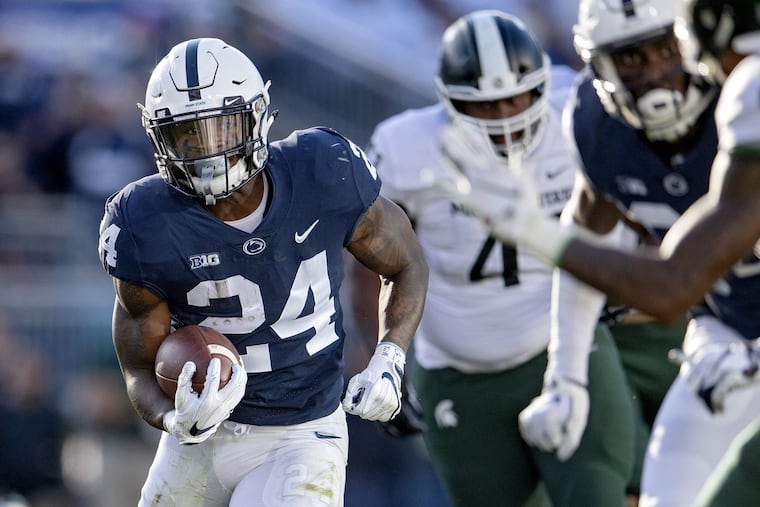Five observations from Penn State’s loss to Michigan State
Saturday's last-minute defeat raised questions about the Nittany Lions' ability to keep a fourth-quarter lead.

The Penn State Nittany Lions lost Saturday to Michigan State, 21-17, to fall to 4-2 overall and 1-2 in the Big 10. Here are five takeaways from their second straight defeat.
Penn State needs a knockout punch
The Nittany Lions are 24-5 since their 2016 flop at Michigan, with the five defeats coming by three, one, three, one and four points. But the common thread in all five contests is the inability to finish after holding a lead in the fourth quarter. Another theme is a failure to milk time off the clock in the Lions' four-minute and two-minute offense.
In two possessions after Michigan State's failed fake field goal, they held the ball for just 1 minute, 37 seconds and netted only one first down. The Spartans got the ball for their final drive with 1:19 left and expertly managed the clock to the winning touchdown. Head coach James Franklin says he keeps emphasizing the four-minute offense in practice, but it has to translate into proper execution at some point.
Falling behind Big Ten East rivals
Franklin's record against the other powerhouses — Ohio State, Michigan, Michigan State — of one of college football's toughest divisions is a dismal 3-11 in his four-plus seasons as head coach. To be fair, the 2014 and 2015 results happened when Penn State was continuing to battle through scholarship reductions resulting from NCAA sanctions. Still, a 3-5 record since 2016, particularly back-to-back losses to the Buckeyes and the Spartans in the last two games, will not get the Lions to where they want to go – a conference championship, a first-ever appearance in the College Football Playoff.
Remaining games against Michigan as well as Big Ten West contenders Iowa and Wisconsin will tell what kind of team they have, and what kind of questions Franklin will have to ask of himself and his coaches when the season ends.
The offense played tentatively
A sign of the Nittany Lions since Joe Moorhead began his two-year stint as offensive coordinator in 2016 was an aggressive streak, a no-fear approach to throwing the ball down the field. That trademark was nowhere in sight Saturday.
The Lions took precious few shots against Michigan State. Their longest completion was just 25 yards, coming against a team that had been allowing 305 yards per game through the air. Quarterback Trace McSorley pointed the finger at himself, saying he didn't execute the way he should have. But the entire offense, including coordinator Ricky Rahne, has to look in the mirror after that one.
Not counting Miles Sanders' runs of 78 and 48 yards, the Lions averaged 4.3 yards per play. The confidence the offense has played with needs to return — and quickly.
Weekly improvement has stopped
After the Ohio State game, Franklin emphasized the fact that despite the loss, his team continued to show improvement, which it had been doing weekly. There was no improvement to be seen Saturday.
Three defensive penalties continued drives by Michigan State, including a baffling unsportsmanlike-conduct penalty after three straight stops from the 1 that led to the Spartans' first touchdown. One of Franklin's most head-scratching postgame quotes was noting that mistakes happened Saturday that did not happen during the practice week. "If we do something [correctly] all week long and then on Saturday, we do it different, we've got to get those things corrected," he said.
Addressing the field-goal kicking
Freshman Jake Pinegar continued to struggle on field goals, making just one of two – including his first missed kick of less than 40 yards – to keep his season percentage at .500 (4-for-8). Franklin said he will "take a hard look at the kicking game" regarding the execution by the entire field-goal unit.
As for kickers, he has few options. Unlike Pinegar, the three other kickers on the roster are walk-ons. Franklin said the kickers hit at a "real high percentage" in practice, but it's a different story once you're inside a stadium with more than 100,000 people, nearly all of them expecting a kicker, no matter how young, to make it.